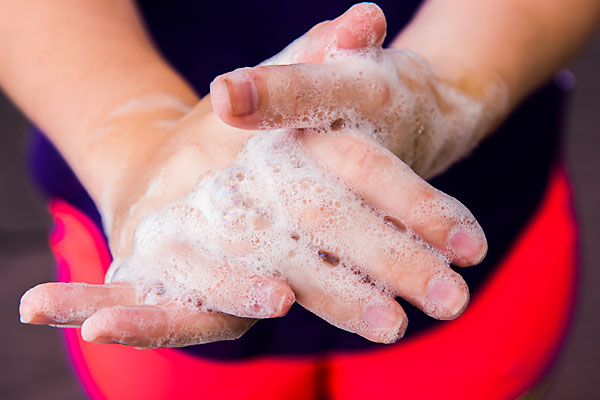You Asked: Is hand soap better than hand sanitizer?

A smiling man or woman leans across a sink with hands full of foamy soap suds. “Stop Germs! Stay Healthy! “Wash your hands!” is plastered below them in all caps. This timeless advice still rings true. Keeping your hands clean is the most powerful way to stop the spread of bacteria and viruses.
With the rise of a population constantly on-the-go, hand sanitizer dispensers have popped up in airports, grocery stores, and even most schools and college campuses–advertising a convenient and fast way to rid your hands of unwelcome germs. But, do they really remove contagions as well as old-fashioned soap and water?
“Using plain, old soap and water is generally more efficient at removing bacteria from our hands,” said Alison Pittman, MSN, RN, CPN, clinical assistant professor at the Texas A&M Health Science Center College of Nursing. “Hand sanitizers are not as effective when your hands are visibly greasy or dirty. In those instances, it’s better to use soap and water to ensure the optimal removal of bacteria.”
According to the Centers for Disease Control (CDC), the alcohol in hand sanitizer inactivates microbes and viruses while hand washing with soap and water are more effective at inactivating and removing them from your hands. However, certain viruses like C. difficile and norovirus cannot be killed by hand sanitizer. “These viruses are particularly nasty stomach bugs that hand sanitizers won’t kill,” Pittman said. “The CDC recommends always using soap and water during an outbreak of these infections.”
Many people believe hand sanitizers are the magic bullet when it comes to removing germs, but a hand sanitizer will only effectively kill bacteria if it contains 60 percent alcohol or more. “Washing your hands with soap and water should always be your first defense,” Pittman said. “Hand sanitizers are useful if there’s not water or soap available, but they shouldn’t be considered an everyday replacement.”
When it comes to cleanliness, technique is important–and the concept the majority of people get wrong.
“Proper handwashing technique is essential to germ removal,” Pittman said. “You must wet your hands first and then apply soap. Place your palms together and work the soap into the front and backs of your hands and under your nails. Then scrub your hands vigorously for 20 seconds. A good timer is to hum ‘Happy birthday’ twice.”
Spending more time at the sink is an important way to protect ourselves from the myriad contagions floating around this fall and winter. “Remember, you really need a good 20 seconds of friction to remove most contaminants from your hands,” Pittman said.
Media contact: media@tamu.edu


